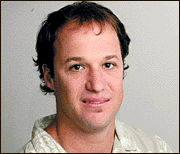

![]()
The why of tech


![]()
The why of tech
Light: the primary source of energy on Earth; the fastest thing in the universe; the thing in the refrigerator that makes you blind when you get a drink in the middle of the night. What would we do without it? A better question is what are we doing with it? Turns out to be a lot. High-tech is
seeing the lightFor one, we are applying its ability to travel faster than any other substance to deliver information to one another. Specifically, we are using light to replace electricity in the network, and perhaps eventually, in computers themselves.
Currently, information, once digitized, is transmitted from one computer to another in blips of electricity very similar to Morse code. Instead of using an alphabet of 26 letters, the information transmitted is either a zero or a one, virtually removing any possibility for transmission error. The computer on the receiving side then assembles the billions of zeros and ones transmitted and turns them back into the information that was originally entered into the sending computer.
While both elegant and brilliant, the problem with this system is the network is only as fast as its slowest link. With hundreds of millions of computers hooked up to the Internet, the amount of traffic being transmitted is staggering, causing major traffic jams of data at all of the intersections. In order to speed this up, the idea is to use light.
Light has been used for a number of years, transmitted over fiber-optic cables. But only in the long-distance routes between major network junctions.
In order to direct that traffic from major intersection to final destinations, the information is converted back to electric signals, routed to the proper city, then building, then computer, thus losing any advantage it had by being light. Real excitement is being generated from companies that are working on speeding up these slowest links by converting them to light as well. Specifically, by converting the hardware called "routers" and "switches" from electric signal-based to light-based, the improvements in speed promise to be exponential.
One of the most interesting ways engineers are attempting to direct light signals is with the use of bubbles. By using technology already in use for ink-jet printers, the idea is to create a bubble in the router at the proper time that tells a stream of signals from a city to go to your computer instead of your neighbor's, for example.
Other ideas include using tiny mirrors that send the light to its proper destination.
The potential is exciting.
Steve Jefferson is a Honolulu-based freelance writer
and section editor for InfoWorld. He can be
reached at: stevej@lava.net